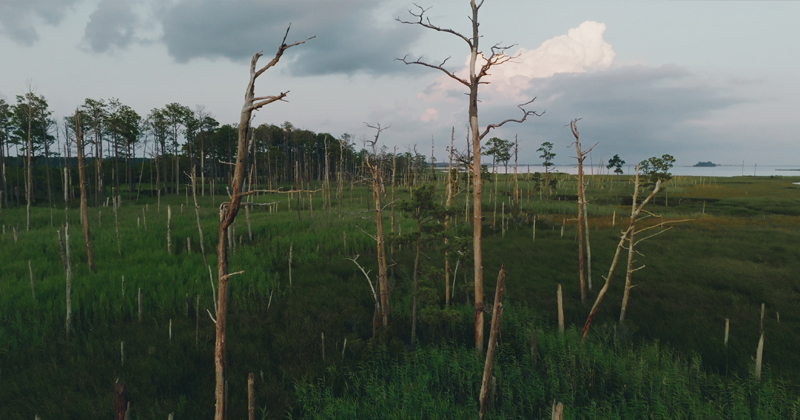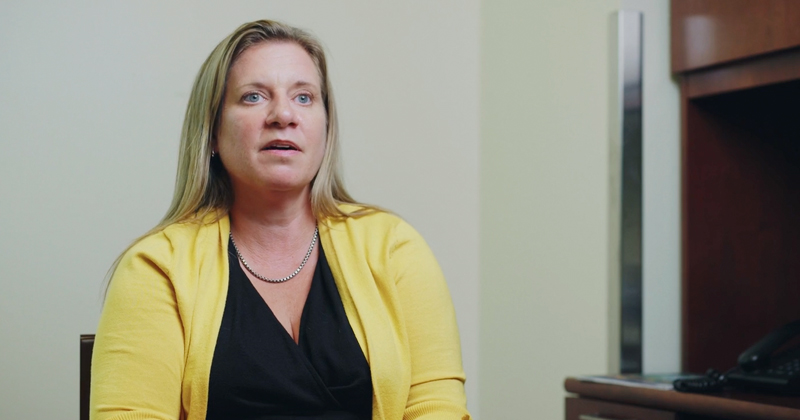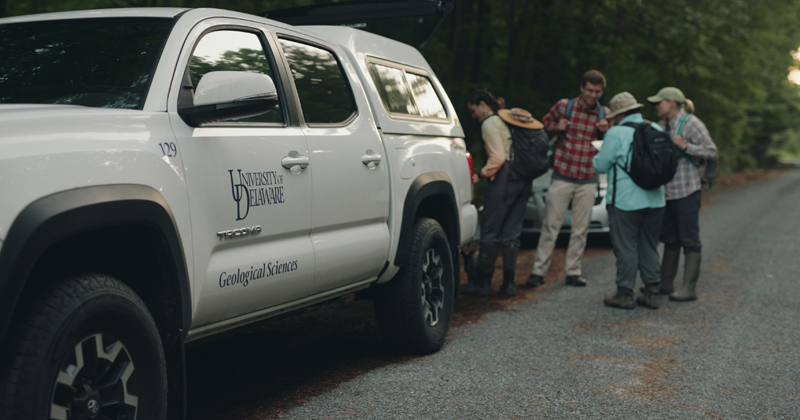


‘Salted Earth’ sheds light on coastal threat
Photos by Ben Hemmings November 13, 2023
UD environmental research highlighted in documentary
Scientists call them “ghost forests,” the acres of once-lush trees now reduced to leafless sentinels along the coast. They are among the visible casualties of seawater intrusion, the movement of saltwater inland to freshwater areas, due to sea-level rise.
It’s a process that “causes salt marshes to move into spaces where forests used to be,” according to Holly Michael, University of Delaware professor and director of the Delaware Environmental Institute.
In the documentary “Salted Earth,” Michael and her colleagues shed light on the seawater intrusion occurring along the Mid-Atlantic coast. They show what’s at stake through the eyes of local residents including Lenape Indian Tribe Chief Dennis Coker and provide insight into their team’s research to mitigate the effects.
Michael, the Unidel Fraser Russell Career Development Chair for the Environment at UD, currently leads a National Science Foundation project to investigate this serious coastal challenge with regional colleagues from the Critical Zone Collaborative Network (CZNet), including researchers from the University of Delaware, University of Maryland, University of Maryland Eastern Shore, Virginia Institute of Marine Science, George Washington University and Boston University.
UDaily asked Michael about the film, her research and the future of coastal areas under threat from sea-level rise.
Q: What motivated you to focus your research on seawater intrusion?
Michael: I have been working on coastal water resources and ecosystems for over 20 years. Coastal systems host half the world’s population and are among the most productive ecosystems on Earth, and seawater intrusion is a major factor in their vulnerability. Coastal freshwater systems sit next to an infinite source of contamination in salt from the sea, and as sea level rises and storms become more intense, they are at greater risk of having their water quality degraded.
On the flip side, our salt marshes provide critical habitats and sequester large amounts of carbon, which in turn, reduces the acceleration of climate change. They also protect the areas behind them from flooding during storms. As sea level rises, these marshes are drowning on the seaward side, so it is important to understand how they can move inland as seawater intrusion occurs.

Q: Why is sea-level rise such a serious issue along the Mid-Atlantic coast?
Michael: It’s a perfect storm here: The land is sinking while the sea level is rising. In the Mid-Atlantic, the land surface elevation is falling because of the long-timescale response of Earth’s crust to glacial retreat that began thousands of years ago. And sea level is rising at the same time. So, the Mid-Atlantic is seeing among the highest rates of relative sea-level rise globally. To make matters worse, the Mid-Atlantic coastal plain is very flat — Delaware has the lowest average elevation of any state in the U.S. So, it’s doubly vulnerable.
Q: How can we mitigate seawater intrusion going forward — what are the best strategies to prevent further damage?
Michael: There are a number of strategies to mitigate negative effects. One is to manage water resources effectively, considering the various risks of salinization, which means that we should make smart decisions about how much fresh groundwater to pump or surface water to use. There are strategies that can be taken to protect agricultural land and communities from flooding. One approach is to just let the salt marsh migrate naturally into the upland. Although this process may seem counterintuitive, taking up space that was once farm or lawn, it also maintains an important ecosystem that helps protect the land behind it from flooding.

Q: What was it like creating the film, and what message are you hoping the audience will take away from it?
Michael: As a scientist, I had never been involved in making a film. It was fantastic to work with the filmmaking team and to see their creative process. They were able to tell the story of the landscape and the communities in ways we often struggle to, as scientists. I hope the audience will take away new understanding of how sea-level rise is affecting our ecosystems, farms and communities so that together we can develop strategies and solutions to adapt to and mitigate changes.
The 20-minute film was co-produced by Canadian filmmaker Ben Hemmings and journalist Joseph Coppolino with Jon Cox, associate professor of art and design at UD.
A live screening of the film will be held Wednesday, Nov. 15, starting at 6:30 p.m., at Stroud Water Research Center, 970 Spencer Road, Avondale, Pennsylvania. A panel discussion will follow. The event is free; registration is required.
Contact Us
Have a UDaily story idea?
Contact us at ocm@udel.edu
Members of the press
Contact us at 302-831-NEWS or visit the Media Relations website

